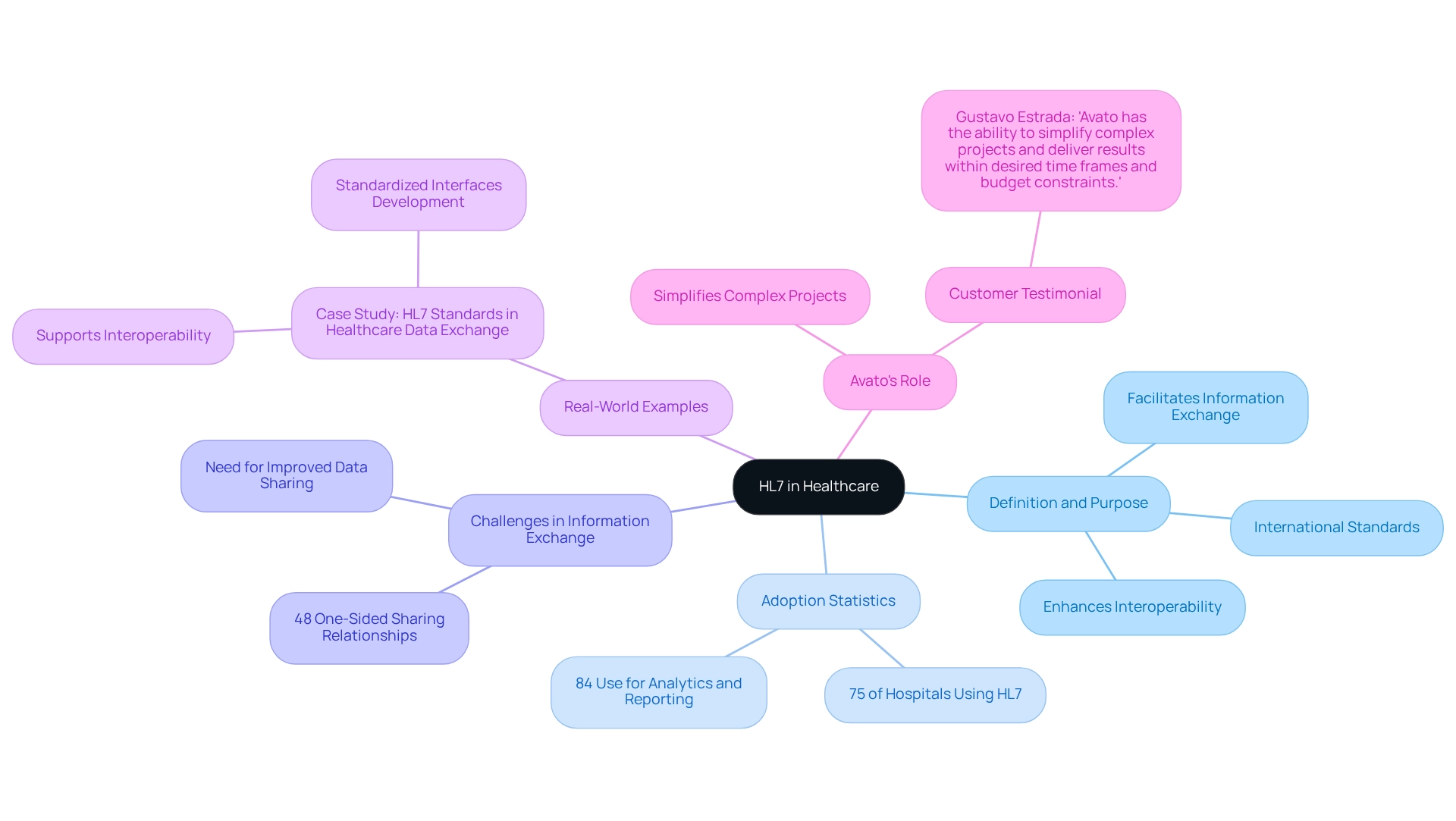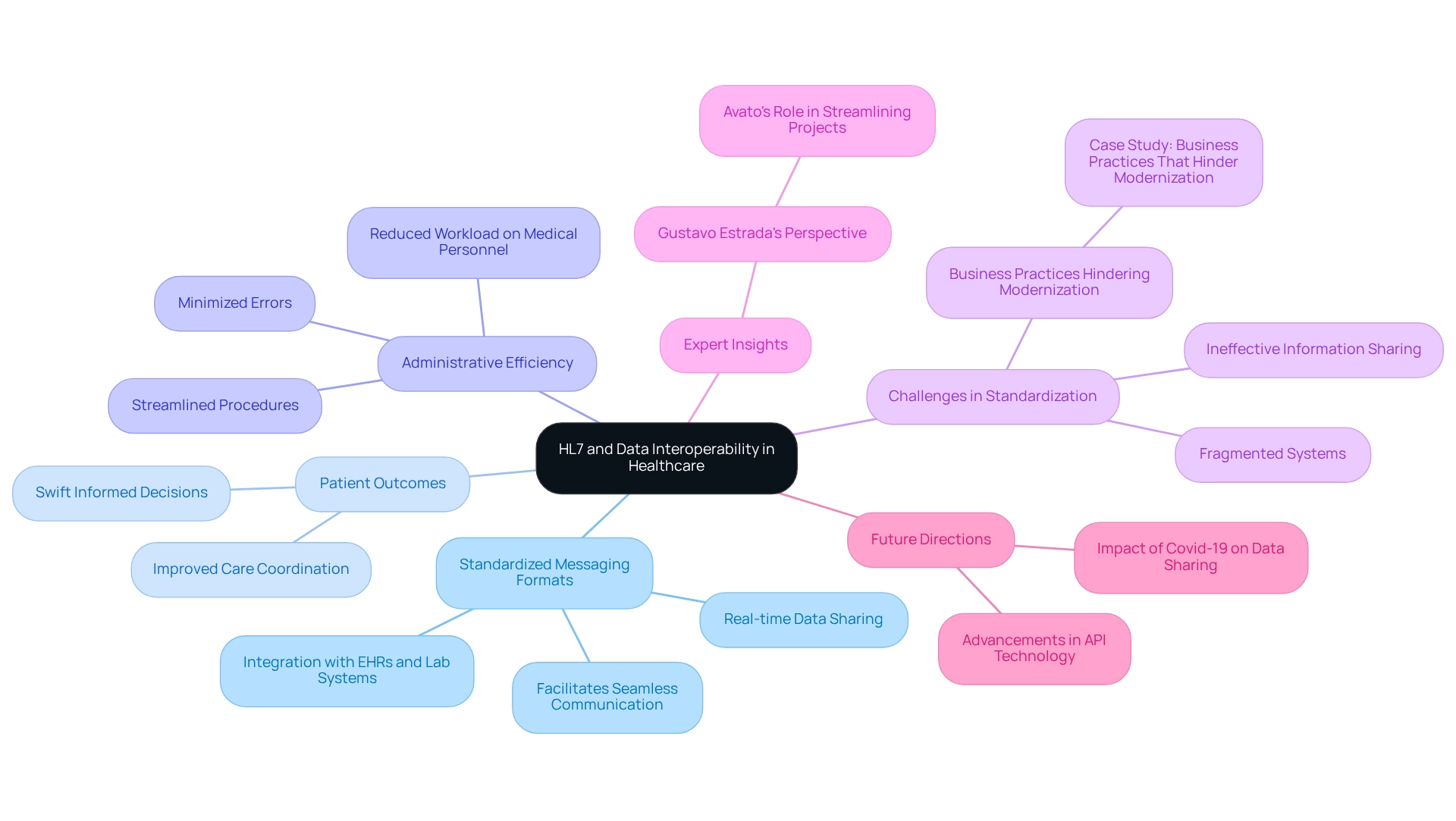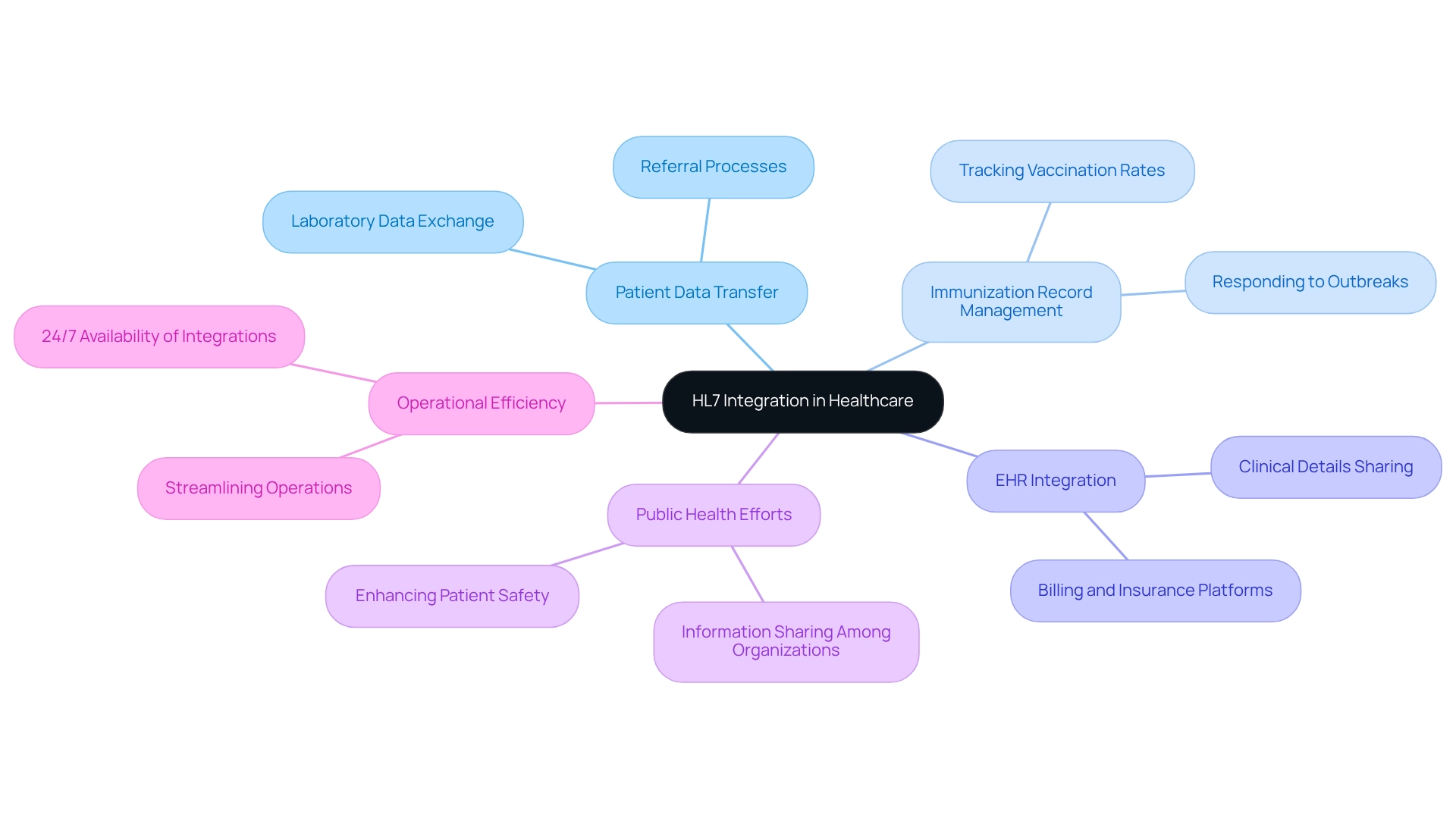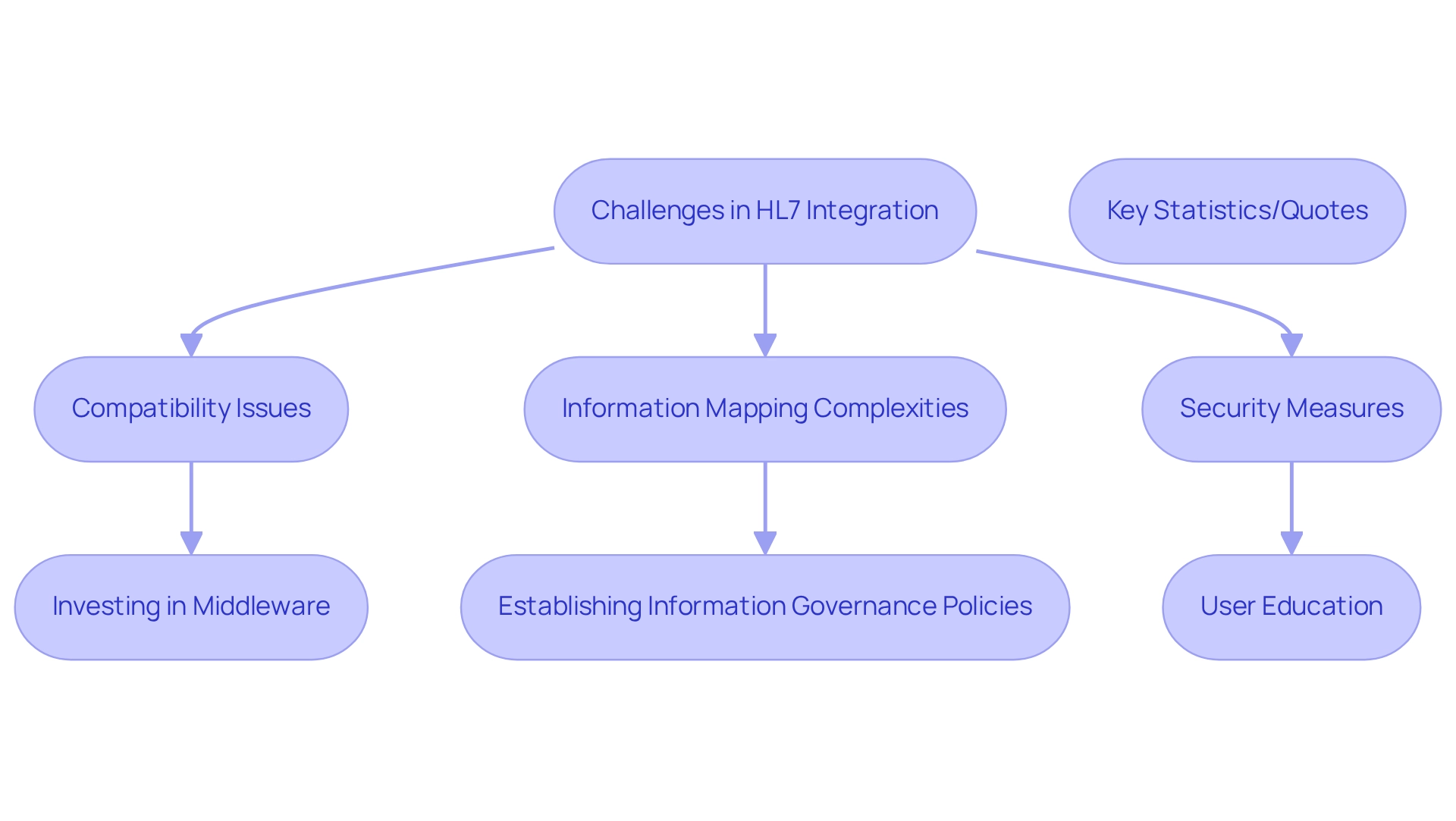Overview
HL7 in healthcare represents a crucial set of international standards designed to facilitate the exchange, integration, and retrieval of electronic health information. These standards significantly enhance interoperability among diverse health information systems.
Why is this important? Because effective patient care relies on seamless communication and data sharing across various medical platforms. As a result, operational efficiency is improved, and patient outcomes are elevated.
Embracing HL7 standards is not just a technical necessity; it is a vital step toward ensuring that healthcare providers can deliver the highest quality of care.
Introduction
In the rapidly evolving landscape of healthcare, the necessity for seamless data exchange has reached an unprecedented level of urgency. Health Level Seven (HL7) standards are pivotal in achieving interoperability among diverse healthcare systems, facilitating the efficient sharing of crucial patient information.
As organizations endeavor to enhance patient care and streamline operations, a comprehensive understanding of HL7—encompassing its various versions and implementation challenges—becomes essential.
This article examines the significance of HL7 standards, elucidating their role in fostering effective communication, compliance, and integration within the healthcare ecosystem. Additionally, it highlights innovative solutions offered by platforms like Avato.
As the industry prepares for a future defined by data interoperability, the insights presented here will illuminate the path forward for healthcare organizations striving to navigate this complex terrain.
Understanding HL7: Definition and Purpose
HL7 in healthcare refers to a comprehensive set of international standards designed to facilitate the exchange, integration, sharing, and retrieval of electronic health information. These standards establish a robust framework for managing both clinical and administrative information, ensuring effective communication among diverse medical systems. The aim of HL7 in healthcare is to enhance the interoperability of health information systems, which is essential in an environment where patient care increasingly depends on integrated information from multiple sources.
As of 2025, a significant percentage of healthcare organizations have adopted HL7 standards, highlighting their critical role in the industry. Reports indicate that nearly 75% of hospitals have integrated bulk information export technology into their Electronic Health Records (EHRs), with analytics and reporting being the most common applications at 84%. However, it is crucial to note that 48% of hospitals reported one-sided sharing relationships, where they share patient information without receiving any in return. This statistic underscores a considerable challenge in medical information exchange that HL7 standards seek to address.
Real-world examples demonstrate how HL7 standards facilitate electronic health information exchange. Medical organizations implementing HL7 standards have reported improved interoperability, enabling seamless communication between disparate systems. A notable case study on HL7 standards in medical data exchange illustrates their essential role in developing standardized interfaces, which are vital for effective data sharing among medical providers.
Understanding HL7 in healthcare is crucial, as the significance of HL7 standards cannot be overstated for achieving interoperability in the medical field. What is HL7 in healthcare? It refers to the standards that ensure different systems can communicate and share information efficiently, playing a pivotal role in enhancing patient care and operational efficiency. Avato, founded by a team of dedicated enterprise architects, embodies a commitment to simplifying complex connection challenges and enhancing business value through its hybrid connection platform.
The name ‘Avato’ reflects this dedication, derived from the Hungarian word for ‘of dedication.’ As Gustavo Estrada, a customer, remarked, “Avato has the ability to simplify complex projects and deliver results within desired time frames and budget constraints.” This highlights the effectiveness of Avato’s solutions in navigating the complexities of medical integration, particularly in addressing the challenges posed by HL7 standards.
As the medical field continues to evolve, understanding HL7 in healthcare remains essential, as it provides a reliable and future-proof technology stack that organizations can leverage to adapt to changing demands.

The Importance of HL7 in Healthcare Organizations
HL7 plays a crucial role in healthcare organizations by fostering interoperability—an essential component for delivering effective patient care. By standardizing information formats and communication protocols, HL7 enables disparate systems to exchange information seamlessly. This capability is particularly critical in emergency situations, where prompt access to accurate patient information can dramatically influence outcomes.
In fact, 71% of hospitals reported having routine access to necessary clinical information from external providers, yet only 42% of clinicians actively utilize this information. This underscores the urgent need for improved integration.
Moreover, understanding HL7 supports compliance with regulatory frameworks such as HIPAA, ensuring that patient information is shared securely and efficiently. It enables organizations to adopt standards that streamline operational workflows, leading to reduced costs associated with data management and enhanced patient care. As we approach 2025, the importance of HL7 in healthcare will only increase, particularly due to ongoing interoperability challenges.
Despite various policy initiatives aimed at improving health information technology, seamless interoperability remains elusive. This highlights the necessity for user-centric design in technology development. Significantly, 50% of medical organizations performed regular cybersecurity audits as of 2022, emphasizing the essential need for security in the context of HL7 and medical integration.
Implementing HL7 standards not only enhances patient care but also clarifies compliance with medical regulations. For instance, hospitals that have integrated HL7 have reported significant improvements in operational workflows, demonstrating the standard’s effectiveness in enhancing care delivery. Avato’s Hybrid Connection Platform accelerates the unification of isolated systems and fragmented data, providing the connected foundation businesses require to simplify, standardize, and modernize their operations.
With support for 12 levels of interface maturity, Avato enables medical organizations to balance the speed of implementation with the sophistication needed to future-proof their technology stack. A case study on user-centric design in health IT revealed that incorporating end-user experiences could help overcome barriers to achieving seamless interoperability, further emphasizing HL7’s pivotal role in modern medical services. Additionally, as noted by an HIE representative, the national effort to expand the scope of exchange stemming from the Cures Act faces challenges with current standards, indicating that while understanding HL7 is crucial, there is still progress to be made in integrating newer standards like FHIR.
Avato’s architecture, trusted by banks, medical institutions, and government, is designed for integration projects requiring 24/7 uptime. This ensures that medical organizations can depend on a rock-solid foundation for their digital transformation initiatives.
Exploring HL7 Versions: V2, V3, CDA, and FHIR
The evolution of HL7 through various versions has been significant, tailored to meet the unique requirements of healthcare information exchange. HL7 Version 2 (V2) remains the most broadly accepted standard, highlighting messaging protocols that enable the exchange of clinical and administrative information in real time—an essential aspect for effective patient care. In contrast, HL7 Version 3 (V3) introduced a more structured methodology by leveraging a Reference Information Model (RIM) to enhance data consistency across systems.
A pivotal element of V3 is the Clinical Document Architecture (CDA), which establishes a framework for the exchange of clinical documents, ensuring that critical patient information is communicated accurately and efficiently.
The most recent progress, Fast Healthcare Interoperability Resources (FHIR), signifies a transformative change in medical system collaboration. FHIR is designed to simplify implementation and enhance interoperability by utilizing modern web technologies, including an HTTP-based RESTful protocol. This modular method not only simplifies the connection with current systems but also facilitates the swift implementation of new applications, rendering it progressively preferred by healthcare organizations.
Avato’s Hybrid Connection Platform plays a crucial role in this landscape, providing key steps for successful digital transformation and system unification. By utilizing XSLT, Avato improves XML transformation, significantly minimizing errors and enhancing efficiency in project implementation. XSLT’s highly-tuned declarative programming features, along with its integration with XPath and extensive information manipulation functions, remove substantial labor in creating transformative tasks for XML structures.
The application of schemas within XSLT guarantees information integrity and results in significant cost reductions, making Avato’s solutions especially beneficial for organizations dealing with the intricacies of medical information exchange.
Real-world examples of FHIR implementation demonstrate its effectiveness in enhancing interoperability. For instance, healthcare providers leveraging FHIR have reported improved patient care outcomes and streamlined administrative processes, showcasing the standard’s potential to revolutionize health data exchange. The unification of FHIR and advanced technologies such as AI and ML is anticipated to enhance patient care and simplify administrative processes, illustrating the essence of HL7 in healthcare, as emphasized in the case study titled ‘Future of HL7 Integration in Healthcare.’
This case study illustrates how Avato’s Hybrid Integration Platform can facilitate the adoption of FHIR, enabling organizations to transition smoothly from V2 and V3 to capitalize on its flexibility and ease of use.
In summary, HL7 in healthcare encompasses the differences between HL7 V2, V3, CDA, and FHIR, characterized by their respective focuses on messaging, structure, and contemporary connectivity features. As the medical landscape continues to evolve, the incorporation of advanced technologies alongside FHIR is expected to further enhance data querying and analysis while prioritizing security protocols to protect sensitive patient information. Furthermore, it is essential to oversee forthcoming EHR WG topics for reaffirmation or retirement, as these changes will have significant consequences for medical system collaboration in the future.
Gustavo Estrada from BC Provincial Health Services Authority remarked, ‘Avato has the capability to streamline intricate projects and produce outcomes within specified timelines and budget limitations,’ highlighting the significance of efficient integration solutions in the medical field.
How HL7 Enhances Data Interoperability in Healthcare
HL7 significantly enhances information interoperability in the medical field by establishing standardized messaging formats that facilitate seamless communication among various systems. This interoperability is crucial for ensuring that patient information is readily accessible across diverse platforms, including electronic health records (EHRs), laboratory systems, and billing software. By adopting HL7 standards, medical providers can share vital patient data in real-time, which minimizes delays in treatment and bolsters overall care coordination.
Consider the scenario where a patient undergoes laboratory tests; the results can be automatically sent to their EHR. This immediate access empowers medical providers to make swift, informed decisions, thereby improving patient outcomes. Furthermore, the integration of HL7 standards streamlines administrative procedures, alleviating the workload on medical personnel and reducing the likelihood of errors.
Recent studies indicate that advocating for specific information elements and standardized API technology, including formats such as XML and JSON, is expected to enhance both care delivery and information utilization. However, prevailing business practices in the medical sector often fail to promote the standardization of laboratory information coding, resulting in fragmented systems and ineffective information sharing. A case study titled “Business Practices That Hinder Modernization” underscores these challenges, suggesting that developing prototype systems for health information management could illustrate the advantages of interoperability, ultimately enhancing patient care and research outcomes.
It is important to note that the study encountered limitations, including a small sample size due to a two-week time constraint and the impact of Covid-19 on appointment numbers, which may influence the generalizability of the findings.
Expert insights further illuminate the role of HL7 in healthcare and its importance in improving information interoperability. For instance, Gustavo Estrada from BC Provincial Health Services Authority emphasized Avato’s ability to streamline complex projects, which is vital in addressing the challenges of medical system unification, particularly concerning HL7 standards. As we approach 2025, HL7 will continue to be instrumental in facilitating real-time data sharing for effective medical coordination in patient care.
Avato’s dedicated hybrid unification platform is pivotal in this landscape, ensuring that disparate systems can communicate effectively, ultimately enhancing business value and patient outcomes. Moreover, Avato actively engages stakeholders to design business processes, guaranteeing that strategies align with the needs of all parties involved, including Banking IT Managers who seek efficient solutions in medical system coordination.

Common Use Cases for HL7 Integration
Understanding HL7 in healthcare reveals its critical role in facilitating the exchange of vital patient information across various entities. HL7 connectivity is essential, enabling the transfer of patient data between hospitals and laboratories, sharing clinical details among specialists, and integrating Electronic Health Record (EHR) systems with billing and insurance platforms. For example, when a patient is referred to a specialist, HL7 standards ensure the seamless transfer of their medical history and test results, equipping the specialist with all necessary information for effective treatment. This integration is crucial for timely and informed decision-making in patient care.
Furthermore, HL7 plays a significant role in managing immunization records, allowing public health agencies to efficiently track vaccination rates and respond to outbreaks. The application of HL7 standards not only enhances patient care but also supports broader public health efforts by facilitating information sharing among various medical organizations. Statistics indicate that a substantial percentage of hospitals utilize HL7 for lab data exchange, underscoring its importance in streamlining operations and improving patient outcomes.
Avato guarantees 24/7 availability for essential connections, a vital factor in preserving the dependability of HL7 systems within medical environments. As the medical field evolves, understanding HL7 in healthcare becomes essential for facilitating patient information exchange between providers, ensuring care is coordinated and comprehensive. Avato’s hybrid unification platform focuses on simplifying diverse systems and enhancing business value, making it an indispensable asset in the medical field.
Ultimately, this scenario benefits both enterprises and their customers, as emphasized by Ivan Dunskiy, CEO. The implementation of HL7 interoperability involves transitioning to a live environment, monitoring data exchanges, and refining configurations as necessary, which enhances the overall effectiveness of the process. Additionally, FHIR assists medical institutions in complying with regulatory standards, such as the 21st Century Cures Act in the US, thus improving patient safety and quality of care.
Avato, derived from the Hungarian word for ‘of dedication,’ embodies a commitment to architecting the technological foundation necessary for rich, connected customer experiences.

Challenges and Solutions in HL7 Integration
What is HL7 in healthcare connectivity? While it offers significant advantages, it also presents substantial challenges that healthcare organizations must navigate. Compatibility issues frequently arise between different HL7 versions, complicating the integration process. Furthermore, the complexities of information mapping can lead to inefficiencies and information silos, particularly when integrating legacy systems that lack support for HL7 standards.
These challenges necessitate robust security measures to protect sensitive health information during data exchange. To effectively address these issues, healthcare providers are increasingly investing in middleware solutions designed to facilitate seamless communication between disparate systems. Middleware serves as a bridge, allowing different applications to collaborate, thereby enhancing interoperability. Avato’s expert unification services provide the skilled support necessary for the effective implementation of these middleware solutions, ensuring organizations can navigate the complexities of HL7 unification with confidence.
Avato offers a range of support services, including:
- Advice on incorporation strategies
- Execution of middleware solutions
- Ongoing maintenance to guarantee optimal performance
Additionally, establishing clear information governance policies is vital for ensuring quality and consistency across platforms, which is essential for effective patient care. Avato’s hybrid connectivity platform empowers companies to prepare their operations for the future through smooth information and system connections, enabling healthcare organizations to access isolated resources and generate business value.
Educating personnel on HL7 in healthcare and the connection processes is another critical measure for reducing errors and enhancing the efficiency of information exchange. A user-centric approach in health information technology (HIT) development can also help overcome barriers to achieving interoperability, focusing on the needs and workflows of end-users.
Statistics indicate that a significant portion of organizations are currently investing in middleware to address HL7 connectivity challenges, reflecting a growing awareness of its importance. For example, a recent study highlighted that as the number of state and regional health information exchanges (HIEs) declined due to funding challenges and competition, organizations turned to middleware as a viable solution to maintain interoperability. This decline has been attributed to various factors, including mergers and competition from vendor-mediated HIEs.
An HIE representative noted, “They didn’t see how interoperability would help them take care of their patients any better. And our team even said, ‘Well, you can get lab results like instantaneously.’ ‘Yeah, you know, but I get them a day late. It’s fine.’” This sentiment underscores the challenge of demonstrating the value of interoperability to providers.
Moreover, a proposed framework aims to ensure data privacy in interoperable health informatics systems, integrating standardized data models, secure transmission protocols, governance policies, and user education, aligning with the discussion on necessary security measures for data exchange.
Case studies, such as those from TechMagic, illustrate what HL7 is in healthcare by showcasing successful connection solutions that improve patient care and operational efficiency. TechMagic’s extensive experience in compliance and scalability demonstrates how organizations can effectively navigate the complexities of HL7 implementation.
By proactively addressing these challenges and utilizing the appropriate tools and training, including Avato’s expert connection services, medical organizations can unlock the full potential of HL7 connectivity, ultimately enhancing their operational efficiency and patient outcomes. Furthermore, prospective clients can inquire about implementation expenses, timelines, and project recovery alternatives to gain clearer insights into how Avato can assist with their specific requirements.

Key Tools and Technologies for HL7 Integration
Essential instruments and technologies for understanding HL7 in healthcare assimilation include interface engines, information mapping software, and API management platforms—each playing a vital role in enhancing medical interoperability. Interface engines, such as Mirth Connect and Rhapsody, are crucial for translating and routing HL7 messages, ensuring precise and prompt information exchange between different systems. These engines not only facilitate communication but also help uphold adherence to medical standards, which is essential for organizations operating in regulated environments.
Mapping software further streamlines the integration process by aligning internal information structures with HL7 standards. This alignment is critical for organizations aiming to refine their workflows and enhance information accuracy. By efficiently charting information, medical service providers can minimize errors and improve the quality of patient care.
API management platforms are increasingly recognized for their ability to leverage modern web technologies, allowing medical organizations to enhance interoperability with external systems. These platforms facilitate seamless information exchange, a necessity in today’s interconnected medical landscape. The combination of APIs can significantly reduce the time required for information retrieval and processing, ultimately resulting in improved operational efficiency.
Recent advancements in HL7 standards, particularly the Fast Healthcare Interoperability Resources (FHIR), promise to further enhance the functionalities of these tools. FHIR is designed to simplify information sharing and merging, transforming it into a revolutionary asset for medical organizations seeking to modernize their systems.
Avato’s hybrid unification platform exemplifies a dedicated strategy to streamline diverse systems and boost business value in the medical sector. By utilizing Red Hat’s open-source solutions, Avato enables organizations to achieve seamless and secure data connectivity, ensuring that medical providers can adapt to evolving demands while upholding high standards of interoperability. Case studies, such as those from TechMagic, underscore the successful implementation of HL7 connection solutions that ensure secure data exchange and compliance.
These organizations have reported enhanced operational efficiency and improved interoperability, highlighting the tangible benefits of adopting robust HL7 connection tools. For instance, TechMagic’s solutions have been acknowledged for their effectiveness in modernizing legacy systems, a crucial step for medical providers.
Statistics reveal that efficient interface engines can significantly reduce patient journey times, with some solutions capable of decreasing identification times by over 10 minutes. As noted by Adi A AlQudah, proposed solutions could reduce the ‘patient’s journey time’ by more than 14 minutes, showcasing the efficiency of these tools. This efficiency not only enhances patient experiences but also optimizes resource distribution within medical facilities.
In summary, the combination of interface engines, information mapping software, and API management platforms creates a comprehensive toolkit for medical organizations that need to understand HL7 in healthcare to achieve successful HL7 integration. By leveraging these technologies, alongside Avato’s commitment to delivering a reliable technology stack, organizations can enhance their information management processes, ultimately leading to better patient outcomes and heightened operational efficiency.
The Future of HL7: Trends and Innovations
The future of HL7 is set to witness significant advancements, primarily driven by the increasing adoption of FHIR as a vital standard for interoperability in the healthcare sector. FHIR’s API-first strategy is transforming the landscape of healthcare information exchange, facilitating the development of applications that seamlessly integrate with existing systems. This transformation not only boosts operational efficiency but also empowers patients by granting them access to their medical records and health information via mobile applications and personal health tools—a capability that Avato actively supports through its hybrid integration platform.
Avato’s Hybrid Integration Platform is meticulously designed to maximize and extend the value of legacy systems, simplifying complex integrations while substantially reducing costs. It offers real-time monitoring and alerts on system performance, enabling organizations to respond promptly to any emerging issues. As the focus on information security and privacy intensifies, advancements in HL7 standards will be essential to safeguard patient information during transmission. The evolving regulatory landscape necessitates that health plans invest in robust information encryption and cybersecurity infrastructures, ensuring compliance while fostering trust among patients and providers alike.
Avato’s commitment to secure connectivity aligns seamlessly with these demands, underscoring the importance of security in their platform, which is relied upon by banks, the medical field, and government sectors.
Emerging technologies, such as artificial intelligence and blockchain, are poised to further enhance HL7 capabilities. These innovations promise to facilitate more efficient information sharing, streamline workflows, and ultimately improve patient care outcomes. For instance, advancements in continuous glucose monitoring systems, like those from Dexcom and FreeStyle, exemplify how real-time data integration can lead to better management of chronic conditions, showcasing the practical applications of FHIR that Avato enables.
As the healthcare landscape continues to evolve, understanding HL7’s role in healthcare remains fundamental to fostering effective communication and interoperability among providers. The ongoing development of FHIR standards, supported by initiatives like the HL7 FHIR Accelerator program, emphasizes the significance of HL7 in healthcare and guarantees that these standards will adapt to meet the evolving needs of the medical ecosystem. This collaborative effort among stakeholders is crucial for enhancing existing standards and creating new use cases, thereby increasing the applicability and effectiveness of FHIR across various medical scenarios.
By 2025, we can anticipate a significant rise in FHIR adoption among healthcare organizations, propelled by the demand for innovative solutions that prioritize patient-centric care and operational excellence. As noted by Gustavo Estrada, a customer of Avato, ‘Avato has simplified complex projects and delivered results within desired time frames and budget constraints.’ Tony Leblanc from the Provincial Health Services Authority adds, ‘Good team. Good people to work with. Extremely professional. Extremely knowledgeable,’ underscoring the company’s effectiveness in navigating these advancements.
Conclusion
The discussion surrounding HL7 standards underscores their critical role in achieving interoperability within the healthcare sector. By establishing a robust framework for the exchange of electronic health information, HL7 facilitates seamless communication among various healthcare systems—an essential component for enhancing patient care. The integration of HL7, particularly through its multiple versions like V2, V3, and FHIR, illustrates its adaptability to the evolving demands of healthcare data exchange.
Healthcare organizations that embrace HL7 standards not only experience improved operational workflows and compliance with regulations but also enhance their ability to provide timely and effective patient care. However, the challenges associated with HL7 integration, including compatibility issues and data mapping complexities, necessitate the adoption of middleware solutions and robust security measures to protect sensitive information.
As the healthcare sector continues to embrace digital transformation, tools and technologies such as Avato’s Hybrid Integration Platform emerge as vital assets in simplifying complex integrations and ensuring effective communication among diverse systems. The future of HL7 promises further innovations, driven by advancements in technology and the growing adoption of FHIR, which prioritizes patient-centric care through enhanced data accessibility and security.
In conclusion, the significance of HL7 standards in facilitating data interoperability cannot be overstated. As healthcare organizations strive to enhance patient outcomes and operational efficiency, leveraging HL7 will be pivotal in navigating the complexities of modern healthcare integration. The ongoing commitment to innovation and collaboration among stakeholders will ensure that HL7 continues to evolve, meeting the dynamic needs of the healthcare ecosystem while fostering a more connected and efficient healthcare environment.

